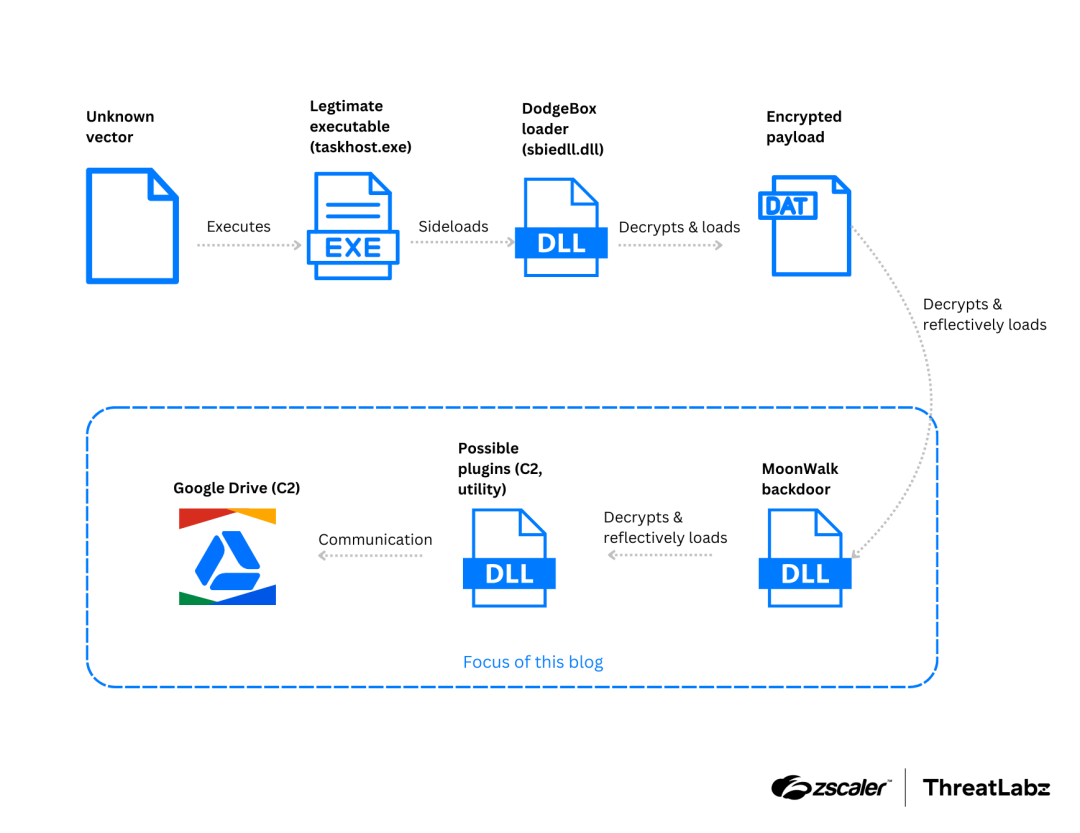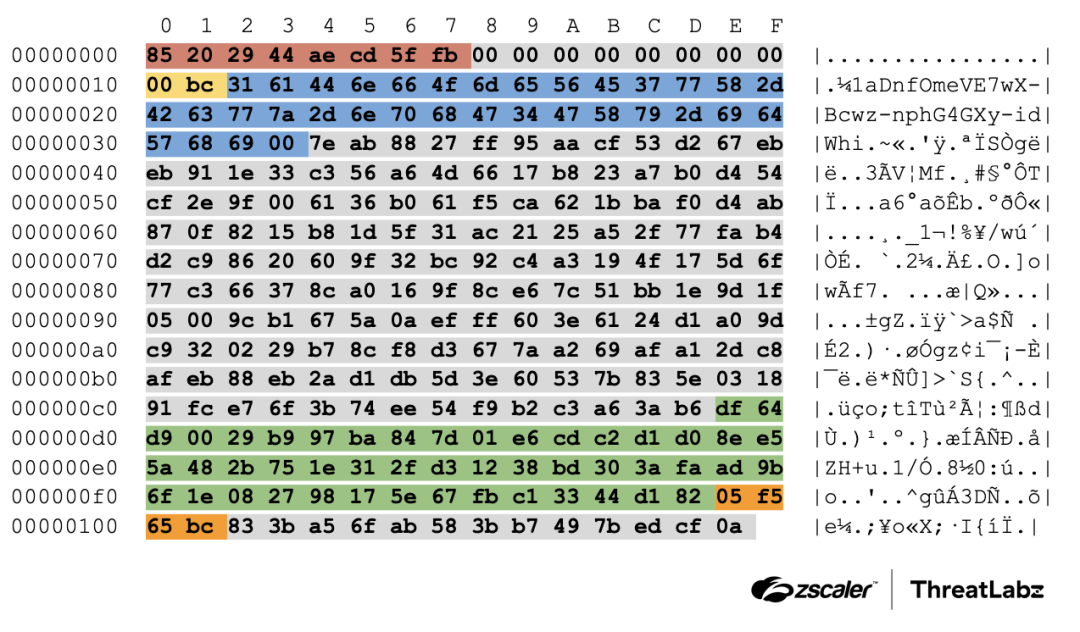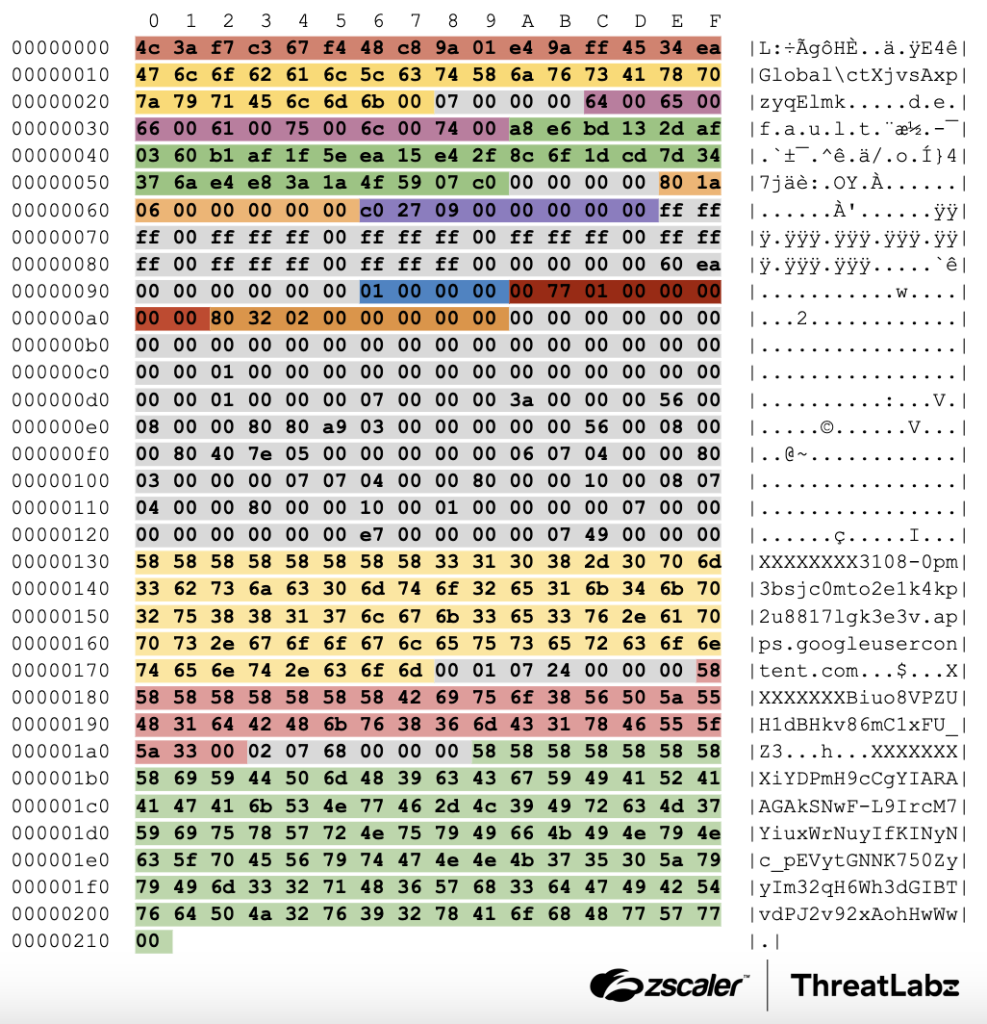Zscaler Blog
Get the latest Zscaler blog updates in your inbox
Subscribe
MoonWalk: A deep dive into the updated arsenal of APT41 | Part 2
Introduction
This is Part 2 of our two-part technical deep dive into APT41’s new tooling, DodgeBox and MoonWalk. For details of DodgeBox, go to Part 1.
In Part 2 of this blog series, we examine the MoonWalk backdoor, a new addition to APT41's toolkit. Continuing from our previous analysis of the DodgeBox loader in Part 1, we have discovered that MoonWalk shares several evasion techniques. It makes use of Google Drive for command-and-control (C2) communication and abuses Windows Fibers, a lesser-known Windows feature, to evade anti-virus (AV) and Endpoint Detection and Response (EDR) solutions.
Key Takeaways
- APT41, a China-based nation-state threat actor known for campaigns in Southeast Asia, has been observed using a new backdoor called MoonWalk.
- MoonWalk shares a common development toolkit with DodgeBox, reusing code that implements evasive techniques such as DLL hollowing, import resolution, DLL unhooking, and call stack spoofing. Additionally, MoonWalk employs further evasion tactics, including the use of Google Drive as its C2 channel to blend in with legitimate network traffic and the utilization of Windows Fibers to evade AV/EDR security solutions.
- MoonWalk's modular design allows attackers to easily update its capabilities, modify its behavior, and customize functionality for different scenarios.
Technical Analysis
Attack chain
The focus of this blog post is the second half of the attack chain that begins with the in-memory execution of MoonWalk backdoor. Once the MoonWalk backdoor is successfully loaded by DodgeBox, the malware decrypts and reflectively loads two embedded plugins (C2 and Utility). The C2 plugin uses a custom encrypted C2 protocol to communicate with the attacker-controlled Google Drive account.
A figure depicting the attack chain used to deploy MoonWalk with the DodgeBox loader is shown below.

Figure 1: Attack chain used to deploy the DodgeBox loader and MoonWalk backdoor.
MoonWalk analysis
MoonWalk is a malware backdoor written in C that shares many code similarities with DodgeBox, suggesting a common development toolkit. It incorporates many evasion related functions from DodgeBox, including those related to the following:
- DLL hollowing
- Import resolution
- DLL unhooking
- Call stack spoofing
Additionally, MoonWalk utilizes the same DLL blocklist as DodgeBox.
ThreatLabz analysis reveals MoonWalk's modular design, allowing it to load different plugin components as needed. The sample examined by ThreatLabz contains two embedded plugins, a C2 plugin for C2 communication, and a utility plugin that provides functionality related to compression and public-key cryptography. This modular architecture makes MoonWalk highly adaptable, enabling attackers to customize its functionality for different scenarios.
In the section below, we will highlight several notable capabilities of MoonWalk.
Unloading the DodgeBox loader
When MoonWalk first initializes, it resolves its imports using the same algorithms as DodgeBox. Then, depending on the DodgeBox configuration parameter Config.fShouldUnloadStealthVector, MoonWalk unloads the DodgeBox DLL from memory and unlinks it from the Process Environment Block (PEB). This reduces MoonWalk’s in-memory footprint, and obfuscates its origins, hindering memory forensic analysis.
Using Windows Fibers
Next, MoonWalk initializes global structures used to manage Windows Fibers. Windows Fibers are a lightweight threading mechanism, available in the Windows operating system since Windows NT SP5. Unlike traditional threads, which are scheduled by the operating system, fibers are cooperatively scheduled by the application itself. This allows developers to tune an application’s performance for a specific workload. However, due to the complexity of utilizing Windows Fibers, and performance improvements of computer hardware, Windows Fibers were not widely adopted, and remains an obscure feature.
However, with the increased focus on cybersecurity in recent years, there has been an uptick in interest in Windows Fibers from the research and red-teaming community. Multiple research papers (1, 2, 3) and open-sourced proof of concepts (POCs) have been published, abusing Windows Fibers to evade AVs/EDR solutions.
APT41 may have been following these developments, as they have incorporated Windows Fibers into the MoonWalk backdoor. At a high level, MoonWalk maintains a global array of fibers. When a function needs to be executed as a fiber, a fiber is created using the CreateFiber API. This fiber is then packaged together with the address of the function and its arguments and other metadata, and inserted into the global array. The main fiber then schedules these fibers for execution. This use of Windows Fibers helps MoonWalk evade AVs and EDRs which do not support the scanning of Windows Fibers, and also makes analysis challenging by breaking up the control flow.
Configuration
MoonWalk decrypts its configuration, which is hard-coded within its .lrsrc section. Like DodgeBox, MoonWalk uses MD5 for configuration validation and AES Cipher Feedback (AES-CFB) for decryption.
However, MoonWalk's configuration is more complex, featuring nested structures and arrays. This configuration contains various execution parameters including the following:
- Mutex names
- A fiber configuration
- Heartbeat intervals
- Encryption keys
- C2-related data
In the sample we analyzed, MoonWalk's configuration (referred to as Config) included OAuth secrets used to authenticate with the attacker-controlled Google Drive account, and other notable fields as shown below:
Config.szClientID: XXXXXXXX3108-0pm3bsjc0mto2e1k4kp2u8817lgk3e3v.apps.googleusercontent.com
Config.szClientSecret:XXXXXXXXBiuo8VPZUH1dBHkv86mC1xFU_Z3
Config.szRefreshToken: XXXXXXXXiYDPmH9cCgYIARAAGAkSNwF-L9IrcM7YiuxWrNuyIfKINyNc_pEVytGNNK750ZyyIm32qH6Wh3dGIBTvdPJ2v92xAohHwWw
Config.rgbXorKey:a8e6bd132daf0360b1af1f5eea15e42f8c6f1dcd7d34376ae4e83a1a4f5907c0
Config.szMutexName:Global\ctXjvsAxpzyqElmk
Config.szName:default
After loading the default configuration, MoonWalk searches for a new configuration file at C:\ProgramData\[MD5(Config.rgbIDBytes)]. If found, the malware decrypts and loads this file. A sample of MoonWalk's decrypted configuration is available in the Appendix of this blog for reference.
Unpacking and loading plugins
MoonWalk then extracts embedded plugins from the .lrsrc section. In the MoonWalk sample we analyzed, there were two plugins embedded within this section: one plugin for C2, and another plugin which provides utility functions such as public key cryptography and compression.
Each plugin in the .lrsrc section is prefixed with 72 bytes of metadata, which includes AES-CFB secrets, an MD5 checksum, and plugin type information. The plugin type information fields provide information about the features of a plugin. These fields help identify whether a plugin serves as a command handler, C2, or utility. More details about the structure of plugin metadata can be found in the Appendix section.
MoonWalk organizes these plugins by registering them in a global linked list. MoonWalk then goes through this list to load the C2 plugin and its dependencies, such as the utility plugin, using DLL hollowing. This process is similar to what we previously described in Part 1 for DodgeBox. Like DodgeBox, this MoonWalk sample stores a copy of the host DLL in C:\Windows\Microsoft.NET\assembly\GAC_MSIL\System.Data.Trace.
Network Communication
After loading the C2 plugin, MoonWalk is prepared to establish communication with the C2 server. MoonWalk utilizes Google Drive for C2 communications. This helps MoonWalk evade detection, as traffic to and from reputable cloud services are less likely to raise suspicion, especially if a target is already using this service. Strangely, MoonWalk uses the string curl/7.54.0 as its User-Agent when making HTTP requests, even though it does not utilize libcurl in its C2 plugin, and uses the WinHTTP family of APIs instead.
At a high level, MoonWalk communicates over Google Drive in the following manner:
Step | Description |
|---|---|
1 - Initialization | MoonWalk obtains an access token from the Google Authorization Server, by utilizing the OAuth secrets in its configuration ( MoonWalk generates 16 random bytes, and hex-encodes them, resulting in a string such as: MoonWalk uses the Google Drive APIs to retrieve the ID for the MoonWalk retrieves the ID for the |
2 - Cryptographic Handshake (Client Hello and Server Hello) | MoonWalk searches /data/temp for a file named after the generated MoonWalk then looks for the Lastly, MoonWalk searches for the |
3 - Information Gathering | MoonWalk then checks for the existence of the directory |
4 - Heartbeat | MoonWalk then proceeds to send heartbeats regularly to the C2 server by updating a file named “ MoonWalk also regularly polls the |
Table 1: High-level view of the MoonWalk C2 communication protocol using Google Drive.
Cryptographic Handshake (Client Hello)
During the cryptographic handshake phase, MoonWalk exchanges AES keys with the server using a custom protocol. Because of this, it becomes very difficult or impossible to decode encrypted C2 messages without access to these AES keys, which exist only in MoonWalk’s process memory.
The process begins with MoonWalk generating a 32-byte AES key (rgbClientAESKey) and a 16-byte initialization vector (IV) (rgbClientAESIV) using a custom random number generator. The AES key is then treated as an Elliptic-curve Diffie-Hellman (ECDH) private key, to generate the corresponding ECDH public key (rgbECDHPublicKey) using the curve25519_donna function.
MoonWalk then encodes the ECDH public key and AES IV by XORing them with the XOR key from MoonWalk's configuration (Config.rgbXorKey). A checksum is created by performing an MD5 hash on the concatenation of Config.rgbXorKey, ECDH public key, and AES IV, and then taking the hash’s first four bytes. Finally, MoonWalk uploads this data to Google Drive at the path /data/temp/[SessionID].
The figure below shows content of an uploaded file:

Figure 2: Contents of a MoonWalk Client Hello key exchange message.
The table below provides a description of the various fields contained within the uploaded file:
Offset | Size in bytes | Description |
|---|---|---|
0x00 | 1 | Unknown field, possibly a message type enum. |
0x01 | 32 |
rgbECDHPublicKey before the XOR operation is:
|
0x21 | 16 |
|
0x31 | 4 | First four bytes of |
0x35 | 15 | Unknown bytes. |
Table 2: Description of MoonWalk Client Hello key exchange message.
Cryptographic Handshake (Server Hello)
MoonWalk then downloads the file located at /data/[SessionID]/s1/1. This file contains the server’s response to MoonWalk’s handshake above.
This file, and all subsequent uploaded or downloaded files, are encoded using a custom scheme. Here, we walk through the decoding process of this scheme, using the Server Hello file as an example.
The figure below is an example of the overall layout of the encoded Server Hello file:

Figure 3: MoonWalk Server Hello message format.
A description of these fields is shown in the following table.
Offset | Size in bytes | Description |
|---|---|---|
0x00 | 8 |
|
0x08 | 8 | Unknown, potentially a message type field. |
0x10 | 2 |
The number of encoded bytes that follows. This field is encoded with
|
0x12 | dwNumEncodedBytes |
The encoded bytes within this file. These bytes appear to contain message metadata, such as Google Drive file IDs, message headers, or junk bytes.
To decode these bytes,
|
0x?? | variable |
|
Table 3: Description of the MoonWalk Server Hello message format.
The figure below shows the Server Hello file after decoding:

Figure 4: Example contents of a decoded MoonWalk Server Hello message.
The decoded Server Hello fields are described in the table below.
Offset | Size in bytes | Description |
|---|---|---|
0x00 | 8 |
|
0x08 | 8 | Unknown |
0x10 | 2 |
|
0x12 | variable |
|
0x34 | variable | Unknown |
0xce | 48 | Encoded buffer, XOR encoded with
After decoding, the following fields are revealed:
The remaining bytes after decoding contain a checksum, and additional unknown bytes. |
0xfe | 4 | Checksum generated by |
0x102 | variable | Unknown |
Table 4: Description of fields within a MoonWalk Server Hello message.
With this information, MoonWalk generates a public key (rgbECDHServerPublicKey) using the curve25519_donna function. Then, rgbECDHServerPublicKey is XORed against Config.rgbXorKey to generate the server AES key.
Curve25519_Donna(
a1->rgbECDHServerPublicKey,
// Public Key (out):
// 000001e6`246391ec b5 8f a7 ee 0b da d6 79-79 60 85 79 bf 32 ad 91
// 000001e6`246391fc 24 a3 39 66 4c 4b 49 97-6c 71 92 d3 55 45 4b 3e
a1->rgbClientAESKey,
// Private Key:
// 000001e6`2463920c 54 be fd a7 f4 0f 62 15-fb 22 9a 48 04 e3 6e 90
// 000001e6`2463921c 85 4b b9 c7 f2 5f de 57-65 59 9c 90 18 04 d9 d1
a1->rgbECDHServerBasepoint);
// Basepoint:
// 000001e6`24639251 77 82 64 13 04 16 94 da-35 d2 1e b8 27 d7 35 ff
// 000001e6`24639261 02 8a 47 85 56 41 29 5b-cb 3b 28 22 f2 69 3d 3a
rgbServerAESKey = rgbECDHServerPublicKey ^ Config.rgbXorKey
// 1d 69 1a fd 26 75 d5 19-c8 cf 9a 27 55 27 49 be
// a8 cc 24 ab 31 7f 7e fd-88 99 a8 c9 1a 1c 4c feIn this manner, MoonWalk exchanges AES keys with its C2, and thus concludes the cryptographic handshake.
Information gathering
During this phase, MoonWalk collects information about the environment and uploads it to Google Drive. The gathered data includes details such as the processor architecture, Windows product type, version and build numbers, computer and usernames, as well as IP addresses. This information is then compressed using LZ4. A checksum is then added, using the 32-bit MurmurHash2 algorithm, with a customized mixing constant where r is set to 15, and with the initial seed set to 0x12345678. These bytes are then encrypted using AES-CFB with the server’s AES key, and packaged using the custom scheme detailed above, before being uploaded to Google Drive.
More details of the environment information collected are provided in the Appendix of this blog.
Heartbeat
MoonWalk also regularly sends heartbeats to the server. It uploads the current Unix timestamp in plain text to a temp.txt file on Google Drive, using the file ID szHeartBeatFileID retrieved as part of the cryptographic handshake.
Backdoor capabilities
In our analysis of MoonWalk, we did not observe the C2 sending any other commands or plugins. If a command handler plugin (dwPluginTypePart2 == 1 described in the Appendix) is not found, MoonWalk defaults to a built-in list of handlers. These handlers contain functionality, which include the following:
- Collect environment information (similar to the information gathering step above)
- Steal token (token impersonation)
- Create token (log on to the Windows machine using given credentials)
- Download new configuration
- Execute command line commands
Note: This list is not complete as further analysis is required.
Conclusion
MoonWalk is a sophisticated and modular backdoor that incorporates evasion techniques seen in DodgeBox. It also introduces innovative techniques, including the utilization of Windows Fibers, which are not commonly observed. These evasion techniques combined with the usage of a custom complex C2 communication protocol abusing Google Drive to blend in with legitimate traffic highlights the highly skilled nature of the APT41 threat adversary.
We continue to closely monitor the latest tactics, techniques, and procedures (TTPs) of this threat actor to protect our customers and share research with the security community.
Zscaler Coverage
Zscaler’s multilayered cloud security platform detects indicators related to DodgeBox at various levels with the following threat name.
Indicators Of Compromise (IOCs)
MD5 Hash | Description |
|---|---|
5b1e8455291d99a1724327b9a7fc2616 | MoonWalk backdoor (related to DodgeBox loader with MD5: d72f202c1d684c9a19f075290a60920f). |
b69984cbf52b418673bd08279ca845d6 | Utility plugin |
5217b8552321556ea434474377cfcd02 | C2 plugin |
bfd6286bb39a0e24a2af28c63bd8e194 | MoonWalk backdoor (related to DodgeBox loader with MD5: 393065ef9754e3f39b24b2d1051eab61). |
75bfb7d5199bf0c4e62525099b33e14f | C2 plugin |
f68ef9e40462c9760bf9c829edd9f4a9 | Utility plugin |
Entity | Description |
|---|---|
GDrive OAuth Client ID #1 | XXXXXXXX5917-dudeis843uv3v1lrm1n12jbq9l9a86lq.apps.googleusercontent.com |
GDrive Client Secret #1 | XXXXXXXX8OPdXrMnPIbIvODh4bnYTVtdKJY |
GDrive Refresh Token #1 | XXXXXXXXEqC4HrQVCgYIARAAGAkSNwF-L9IrS7n6zr6G_vE7_huP5uJuMT6aMtOnu3WgmTMRiEc5QJaQgVX4gbUV7ltUbFXVmd5KOZM |
GDrive OAuth Client ID #2 | XXXXXXXX3108-0pm3bsjc0mto2e1k4kp2u8817lgk3e3v.apps.googleusercontent.com |
GDrive Client Secret #2 | XXXXXXXXBiuo8VPZUH1dBHkv86mC1xFU_Z3 |
GDrive Refresh Token #2 | XXXXXXXXiYDPmH9cCgYIARAAGAkSNwF-L9IrcM7YiuxWrNuyIfKINyNc_pEVytGNNK750ZyyIm32qH6Wh3dGIBTvdPJ2v92xAohHwWw |
Threat actor’s email address (linked to GDrive) | jsonmakesam@gmail.com |
Heartbeat related network requests | Description |
|---|---|
Verb:
URL:
URL Params:
User-Agent:
| MoonWalk updating |
Verb:
URL:
URL Params:
User-Agent:
| MoonWalk querying for new commands. |
MITRE ATT&CK Framework
Tactic | ID | Technique | Description |
|---|---|---|---|
Defense Evasion | T1027 | Obfuscated Files or Information | MoonWalk uses AES-CFB to encrypt strings, configurations, and bundled payloads. |
Defense Evasion | T1027.007 | Obfuscated Files or Information: Dynamic API Resolution | MoonWalk uses salted FNV1a hashes to dynamically resolve APIs. |
Defense Evasion | T1620 | Reflective Code Loading | MoonWalk reflectively loads plugin DLLs, utilizing DLL hollowing. |
Defense Evasion | T1106 | Native API | MoonWalk uses Windows Native APIs like |
Defense Evasion | T1562.001 | Impair Defenses: Disable or Modify Tools | MoonWalk utilizes stack spoofing when calling APIs to monitor for security software. MoonWalk performs a scan within its own address space to detect any alterations, such as hooks or debugger breakpoints. If it identifies any signs of modification, DodgeBox takes action to restore the original code from disk, effectively undoing any unauthorized changes made to its code. |
Command and Control | T1102.002 | Web Service: Bidirectional Communication | MoonWalk has a C2 plugin that utilizes an attacker-controlled Google Drive account to implement a C2 communication channel. |
Command and Control | T1573 | Encrypted Channel | MoonWalk leverages a custom network protocol to exchange encrypted C2 messages. |
Reconnaissance | T1592 | Gather Victim Host Information | MoonWalk collects information about the hardware and software configuration of the victim's host. |
Reconnaissance | T1590 | Gather Victim Network Information | MoonWalk collects the IP address of the victim's host. |
Appendix
.lrsrc section
An example of the .lrsrc section from MoonWalk is shown in the figure below.

Figure 5: An example of the .lrsrc section from MoonWalk.
The table below provides a description of the various fields.
Offset | Size in bytes | Description |
|---|---|---|
0x00 | 4 |
Offset from the start of |
0x04 | 4 |
|
0x08 | 4 |
|
0x0c | 4 |
Offset to embedded plugin, containing a plugin’s metadata, followed by the plugin. |
0x10 | 4 |
Size of the plugin including its metadata. |
0x14 | 4 |
|
0x18 | 4 |
|
Plugin metadata
An example of a MoonWalk C2 plugin’s metadata is shown in the figure below.

Figure 6: An example of a MoonWalk C2 plugin’s metadata.
The table below provides a description of the various fields.
Offset | Size in bytes | Description |
|---|---|---|
0x00 | 4 |
|
0x04 | 4 |
A combination of |
0x08 | 4 | Flag to load plugin only if OS and processor information have been successfully collected by MoonWalk. |
0x0c | 4 | Dictates how MoonWalk should retrieve a plugin’s exports. |
0x10 | 4 | Unknown |
0x14 | 16 | MD5 of plugin metadata and plugin data. |
0x24 | 16 | Hashed with MD5 to produce the AES key for decrypting the plugin. |
0x34 | 16 | AES IV |
0x44 | 4 | Size of plugin data that follows. |
Decrypted configuration
MoonWalk's configuration is complex, containing arrays and nested structures of various types, as shown in the figure below. This analysis will focus only on the relevant fields, with non-essential bytes omitted from the analysis. These omitted bytes will either have unknown functionality or contain metadata for parsing the configuration.
An example of MoonWalk’s decrypted configuration is shown in the figure below.

Figure 7: MoonWalk's configuration which contains arrays and nested structures of various types.
The table below provides a description of the various fields.
Offset | Size in bytes | Description |
|---|---|---|
0x00 | 16 |
The MD5 hash of this value is also used to generate the path to override a configuration file on disk. |
0x10 | 24 |
The name of the mutex that MoonWalk uses to ensure only one instance of the backdoor is running. |
0x2c | variable |
Postulated to be the name of the configuration. Since this is the configuration extracted from the binary, it is the “ |
0x3a | 32 |
This is the XOR key used to encrypt C2 communications. In this sample, the value is:
|
0x5e | 8 | Appears to be used as a heartbeat related interval lower bound. |
0x66 | 8 | Appears to be used as a heartbeat related interval upper bound. |
0x96 | 4 |
|
0x9a | 8 | Appears to be used as another heartbeat related interval lower bound. |
0xa2 | 8 | Appears to be used as another heartbeat related interval upper bound. |
0x0130 | variable |
OAuth client ID used to authenticate with Google Drive. |
0x17f | variable |
OAuth client secret used to authenticate with Google Drive. |
0x1a9 | variable |
OAuth refresh token used to authenticate with Google Drive. |
Gathered environment information
This is the list of environment information gathered by MoonWalk and uploaded to GoogleDrive as part of its initialization process.
- Victim hash (FNV1a hash of the concatenation of the computer name
Config.rgbIDBytesand the machine’s GUID). - Windows major and minor version numbers
- Windows build number
- Computer name
- User name
- Executable path (full path to the current process’s executable file).
- Impersonation status
- CPU start time
- IPv4 addresses
- IPv6 addresses
Config.rgbIDBytesConfig.wszConfigName- Various heartbeat related interval fields from MoonWalk’s configuration.
Was this post useful?
Get the latest Zscaler blog updates in your inbox
By submitting the form, you are agreeing to our privacy policy.



